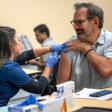Note: The Journal of General Internal Medicine recently published an editorial piece by UCSF-CTSI K Scholar Judy Tan, PhD, and co-authors from the University of Chicago.
INTRODUCTION
As clinicians, educators, and researchers, we promise to heal, cure, and otherwise improve the health of individuals with the utmost respect for human life. Since the 2016 U.S. presidential election, our pledge has taken on new meaning, as we grapple with the impact of unprecedented legislative challenges and a changing social climate on the health of some of the most vulnerable patient populations. Sexual and gender minority (SGM) patients, including those who are lesbian, gay, bisexual, transgender, or queer (LGBTQ), continually face discrimination and violence across healthcare, employment, housing, and education settings.
Relative to the general population, SGM individuals are often sicker and poorer, while facing tremendous barriers in accessing quality medical care and services.
SGM individuals who also identify as racial/ethnic minorities may be even more vulnerable, because the barriers, discrimination, and violence they face as SGM intersect with and are often compounded by those unique to immigration and/or racial and ethnic minority status. Under President Trump’sadministration, SGM who are also racial/ethnic minorities facenew threats to their health and safety due to attacks on protec-tive health and social legislation and the enactment of delete-rious policies. Health disparities will worsen without ourtimely, concerted, and committed advocacy efforts.
Here, we discuss har mful proposed health policies thatwould negatively affect SGM patients of color.6We explainthe health impact of discriminatory policies that create anincreasingly hostile and dangerous environment for sexualand gender minorities, racial/ethnic minorities, and individualswho share both sets of identities. We provide concrete, action-able advocacy steps for clinicians, educators, and researchers,outlining a set of questions to consider as they decide whichadvocacy activities are right for them. We end by discussingspecific advocacy actions for patient care, healthcare organization transformation, medical education, and public policythat can enhance the health of SGM patients of color duringthis critical and challenging time.




